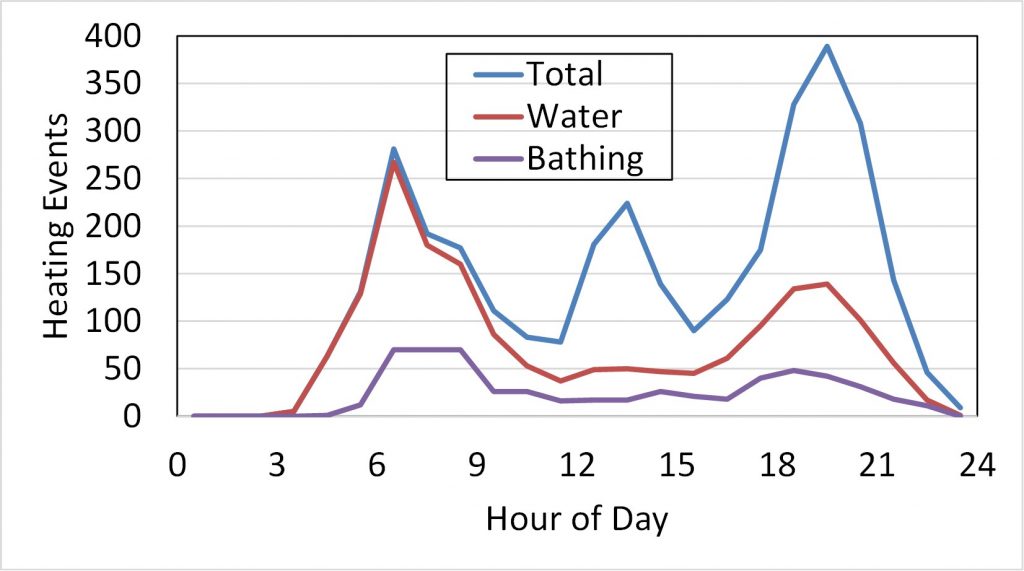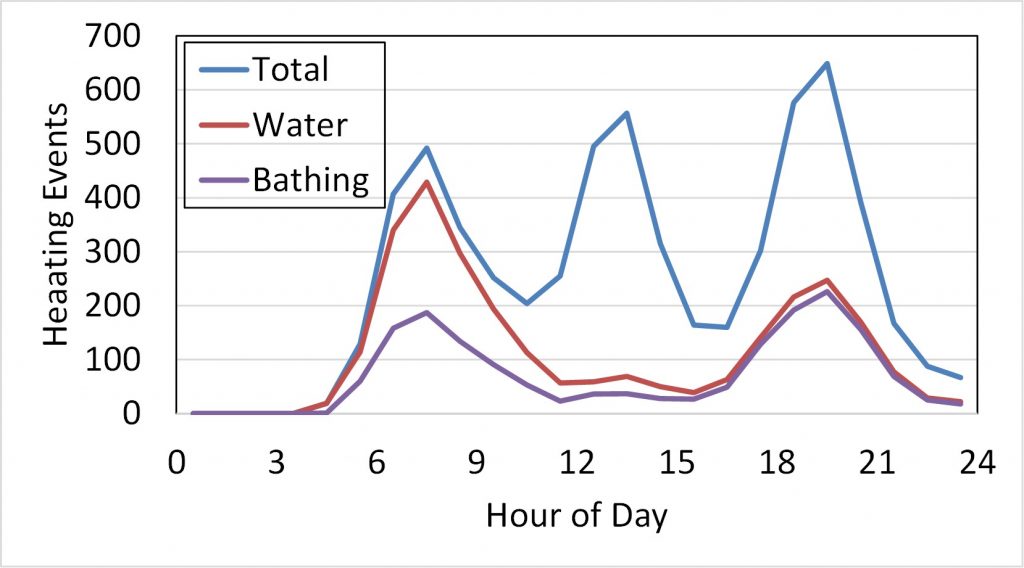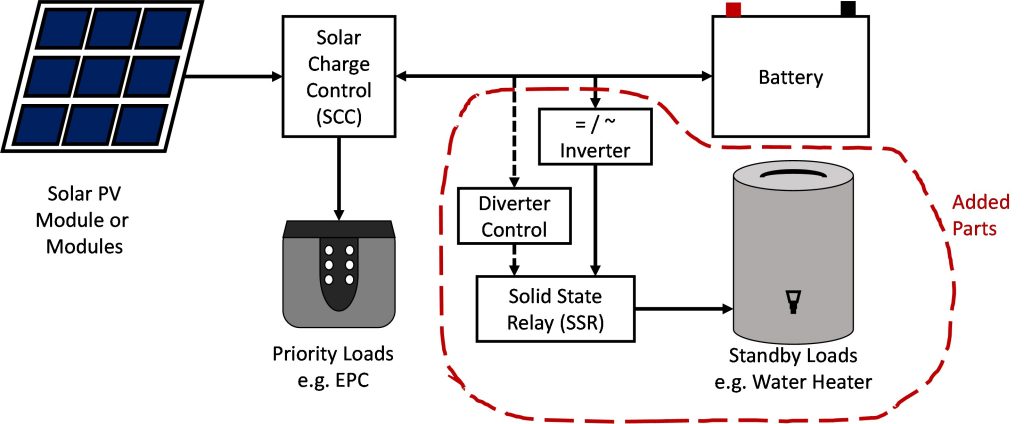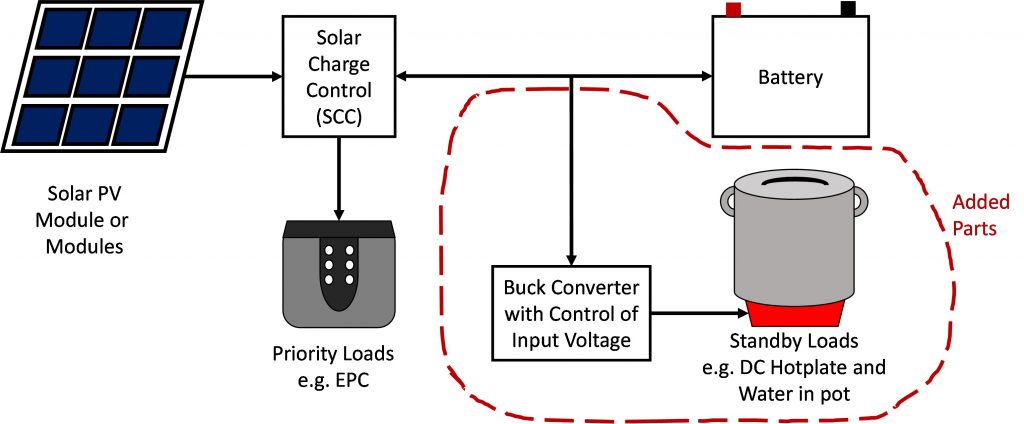
- Date
- 5th July 2021
- Categories
By John Barton (Loughborough University)
The MECS eCooking Power Station pilot to explore battery assisted cooking in Tanzania, Kenya, and Uganda will be deployed in the coming month. Half of these will be off-grid systems demonstrating the use of solar PV power for cooking. The remaining half of the Power Stations are grid-connected to explore the role that energy storage might play in mitigating weak grid connections. The price of such systems will reduce over the coming years as technical innovation and economies of scale bring down the costs. However, energy storage is likely to remain the single most expensive component. In this article, I explore my recent lab work experimenting with using spare solar energy/electricity for water heating. The core idea is that surplus energy from the PV panels could be stored in heated water.
We know from the cooking diaries conducted by MECS and partners that a lot of heating events are for water, either on its own or as part of meal preparation. The pattern of cooking and heating events is similar from country to country, with three peaks corresponding to breakfast, lunch, and the evening meal (see Figure 1 A and B). Water heating events constitute about half of all heating in the cultures we have looked at, and currently take place mainly in the morning although also throughout the day and evening.


The great potential of using solar PV electricity during the day is that water could be heated and stored in an insulated tank or cooking vessel for later use. This could reduce the electricity required from the battery, meaning that the system could use a smaller, cheaper battery to bring the overall cost down.
The eCooking Power stations are designed with an over-sized PV module to ensure a good reliability of battery charging. Therefore, on most days, there is likely to be surplus power during the day, and especially mid-afternoon when the battery is almost fully charged. In the pilot systems the battery then moves from constant current (CC) mode to constant voltage (CV) mode, allowing it to trickle charge while not using all the available solar power.
In my lab work I have explored two different ways of using this surplus power for water heating with as objective to:
- Demonstrate the principle of water heating power diversion in a way that can be deployed in the Kenya, Tanzania and Uganda pilots.
- Develop a technical method of water heating power diversion that is affordable and amenable to mass production in other Solar PV based consumer products
These objectives overlap. Any system deployed with the eCooking Power stations has to be reliable, durable, and fit with the existing system. Two methods have been tried so far:
Inverter with Modulated Output Power
In this system, an inverter is connected to the battery and turned on when diversion of surplus power is chosen. The diverter-controller is an Arduino microprocessor that turns on a solid-state relay on the output of the inverter. The relay is essentially a dimmer switch that chops up the AC waveform to control the output of the inverter to a heating device, for example an urn or kettle, as shown in Figure 2.

The controller measures the battery terminal voltage and sends just the right amount of power to the water heater to maintain the battery voltage within tights limits: Not so high that power is spilled by the solar charge controller, but not so low that the battery stops being charged. This system has the advantage that it works with any off-the-shelf kettle or urn. However, kettles and urns are high power devices (2 kW to 3 kW) and can easily consume much more power than any likely surplus of solar power (up to 300 W). The inverter has significant standing loss and low efficiency at part power. Preliminary experimental results show that inverters have an unstable power draw. The inverter’s own control system continuously ‘hunts’ between low power and high power as it tries to maintain a constant output voltage. Inverters can sometimes draw spikes of up to 100 A of power at 24 V, i.e. 2.4 kW even when the relay is at a low power setting. The power rating of the inverter is determined by the power rating of the heating device, not the surplus power available, and so we are stuck with an over-sized, lossy, expensive inverter.
Buck Converter
This alternative method uses a low-voltage DC heating device driven through a buck converter. This is a type of DC-DC converter whose output voltage is lower than its input voltage, but its output current is higher than its input current (see Figure 3).

An existing buck converter with in-built controller has been reprogrammed to demonstrate the principle of the DC to DC power diverter and results are promising. Again, the controlled voltage must be carefully set at a level where power is not spilled but the battery still charges. The output current of this existing buck converter is limited to 10 V, and this limits the power taken by the DC hotplate to only 120 W.
Ultimately, a more bespoke buck converter is required. This must be programmable and able to control the input voltage. This is a radical departure from existing hardware that is built to deliver a controlled output voltage.
I have been exploring the best combination of off-the-shelf hardware and customised control to demonstrate effective power diversion for water heating. Our MECS colleagues in Bangladesh have also done research on this topic, and specifically looked at integrating solar PV systems with weak grids without the need for an inverter. Their work supports my hypothesis that the inverter could indeed be over-sized, lossy and expensive. This work was done in collaboration with Endev. Further work to design a system that sidesteps an inverter was done by our colleagues in Malawi, who looked at utilising surplus Solar PV capacity to heat water as a prelude to a meal through innovative use of diodes.
The health hazards of standing heated water
However, beyond these technical mechanisms for creating the heated water, it is important to acknowledge that “heated water” has its own challenges. In a previous blog, Martin Price drew attention to the possible ‘brewing of nasties’ that standing heated water could bring. Therefore, it is important to acknowledge that the intention of this lab work exploring the improvement of the system efficiencies by utilising surplus energy on heating water, must be accompanied with consumer awareness. Small quantities of water used fairly immediately for drinking is not an issue, however, problems may occur if the water is heated, then left to cool, and then heated again.
Many of the Tanzania heating events are for washing, and not drinking, in which case the above does not apply. However, this needs to be made clear to the consumer as well. In describing my work above, I talk about a hot plate and a kettle. In earlier work, I looked into the possibilities of the Thermopot. This is an insulated kettle that has the advantage of keeping the stored water hot, but also seemed to implicitly encourage users to retain and refill the pot, meaning the water can ‘brew the nasties’.